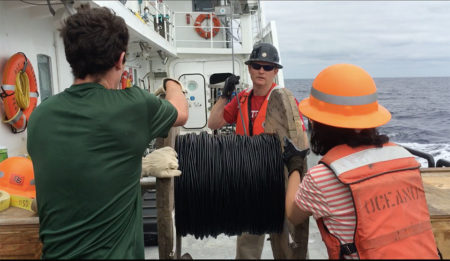We are nearing the end of this 10-day research trip, and as I’m writing, people are bustling around me in the process of deconstructing the labs they set up and packing up their gear. Researchers have made backup copies of the data collected from the various tests conducted, the Carbon Flux Explorers are tucked away in their crates, 700 meters of cable were unspooled from the ship’s winch back onto a reel by hand, and filtering and processing stations – including the “Bubble” – have been taken down.

A group of us took turns hand-spooling 700 meters of cable back onto this reel as part of the packing up process. (Photo: Sarah Yang)
We’re moving along at about 10.5 to 11 knots, which should get us into San Francisco by 6:30 a.m. tomorrow (Tuesday, Aug. 23). We’ll have to offload quickly since the next research team is set to arrive the following day.
By the end of this trip, the researchers have profiled more than 150 kilometers of the ocean’s water column through 26 CTD deployments. The Carbon Flux Explorers collectively gathered more than eight days of data.
Of this expedition’s 10-day allotment, there were 6.5 days when experiments were run, equipment and robots were deployed and recovered, and samples were processed. The rest of the time was spent in transit time to and from stations. Altogether we will have traveled about 750 nautical miles by the time we dock in San Francisco.
Ship time on the Oceanus runs $25,000 per day. With all of the work that went into collecting the particles from the ocean, including the around-the-clock hours from numerous students and engineers before departure, I am confident that the particles and plankton collected are worth more than their weight in gold.
“We’ve accomplished what we set out to do,” said Jim Bishop. “We had an equal number of deployments and recoveries, and I’m thankful for that. We also wanted to torture test the Carbon Flux Explorers and the various sensors used to profile the water. We collected samples from near-shore and oligotrophic waters at various depths. And we gave students invaluable field experience that they will be able to carry with them to wherever their careers take them.”
As is tradition, the cook on the Oceanus treated the crew and research team to a festive meal to celebrate the last full day of the voyage. For lunch today, he served us steak and lobster, and he threw in some crab legs for good measure.
Now that we’re heading back, we should soon reappear on the vessel tracking map, which temporarily lost our signal when we ventured far offshore.
